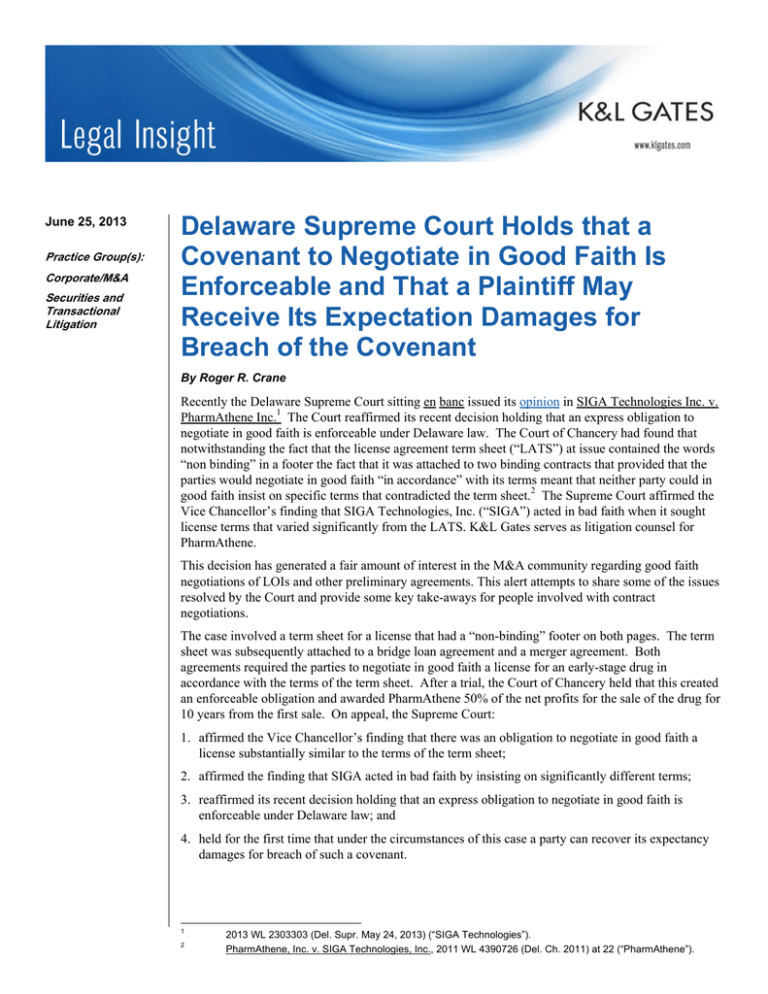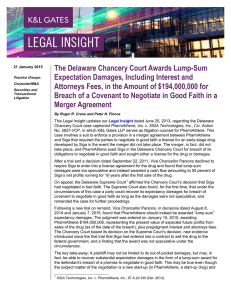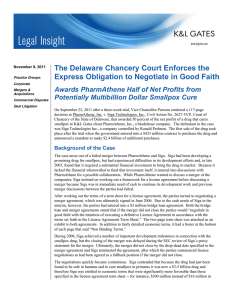
June 25, 2013
Practice Group(s):
Corporate/M&A
Securities and
Transactional
Litigation
Delaware Supreme Court Holds that a
Covenant to Negotiate in Good Faith Is
Enforceable and That a Plaintiff May
Receive Its Expectation Damages for
Breach of the Covenant
By Roger R. Crane
Recently the Delaware Supreme Court sitting en banc issued its opinion in SIGA Technologies Inc. v.
PharmAthene Inc.1 The Court reaffirmed its recent decision holding that an express obligation to
negotiate in good faith is enforceable under Delaware law. The Court of Chancery had found that
notwithstanding the fact that the license agreement term sheet (“LATS”) at issue contained the words
“non binding” in a footer the fact that it was attached to two binding contracts that provided that the
parties would negotiate in good faith “in accordance” with its terms meant that neither party could in
good faith insist on specific terms that contradicted the term sheet.2 The Supreme Court affirmed the
Vice Chancellor’s finding that SIGA Technologies, Inc. (“SIGA”) acted in bad faith when it sought
license terms that varied significantly from the LATS. K&L Gates serves as litigation counsel for
PharmAthene.
This decision has generated a fair amount of interest in the M&A community regarding good faith
negotiations of LOIs and other preliminary agreements. This alert attempts to share some of the issues
resolved by the Court and provide some key take-aways for people involved with contract
negotiations.
The case involved a term sheet for a license that had a “non-binding” footer on both pages. The term
sheet was subsequently attached to a bridge loan agreement and a merger agreement. Both
agreements required the parties to negotiate in good faith a license for an early-stage drug in
accordance with the terms of the term sheet. After a trial, the Court of Chancery held that this created
an enforceable obligation and awarded PharmAthene 50% of the net profits for the sale of the drug for
10 years from the first sale. On appeal, the Supreme Court:
1. affirmed the Vice Chancellor’s finding that there was an obligation to negotiate in good faith a
license substantially similar to the terms of the term sheet;
2. affirmed the finding that SIGA acted in bad faith by insisting on significantly different terms;
3. reaffirmed its recent decision holding that an express obligation to negotiate in good faith is
enforceable under Delaware law; and
4. held for the first time that under the circumstances of this case a party can recover its expectancy
damages for breach of such a covenant.
1
2
2013 WL 2303303 (Del. Supr. May 24, 2013) (“SIGA Technologies”).
PharmAthene, Inc. v. SIGA Technologies, Inc., 2011 WL 4390726 (Del. Ch. 2011) at 22 (“PharmAthene”).
Delaware Supreme Court Holds that a Covenant to
Negotiate in Good Faith Is Enforceable and that a Plaintiff
May Receive Its Expectation Damages for Breach of the
Covenant
The Key Take-Aways
In light of the Court’s holdings, it is critical that if parties do not wish to be bound to terms in the
course of a negotiation that they:
1. do not agree to negotiate in good faith; and
2. make it explicitly clear that there is no intention to be bound to any terms until execution of a
formal agreement.
Background
In late 2005 and early 2006, SIGA and PharmAthene negotiated the terms of the LATS. Each draft,
including the final version, had a footer that said “non binding” at the bottom of both pages and the
final version was never signed. After the final version the parties began merger discussions.
However, SIGA needed an immediate infusion of money. So on March 20, 2006 the parties entered
into a Bridge Loan Agreement.
The Bridge Loan Agreement designated New York as the governing law and specifically
contemplated that the parties might not ultimately agree on a merger or license. However, it obligated
the parties to negotiate in good faith a license agreement in accordance with the terms of the LATS if
the merger did not occur. On June 8, 2006, the parties entered into the Merger Agreement which
contained similar “good faith” language. The Merger Agreement provided that it was governed by
Delaware law. The Merger Agreement had a termination date of September 30, 2006.
The drug that was the subject of the LATS was a potential smallpox antiviral treatment. Shortly after
signing the Merger Agreement, SIGA received a $5.4 million grant for the drug’s development from
the National Institutes of Health and in September another $16.5 million. In addition, the drug had a
successful human safety test and had positive results in a primate test. The Court affirmed the Vice
Chancellor’s finding that at this point SIGA had seller’s remorse.
SIGA refused to extend the merger termination date. PharmAthene then sent SIGA a draft license
agreement that incorporated the terms of the LATS. SIGA responded with a 102-page draft LLC
agreement that varied dramatically from the economic terms of the LATS. For instance, the upfront
payment from PharmAthene increased from $6 million to $100 million and the milestone payments
increased from $10 million to $235 million.
SIGA issued an ultimatum on December 12, 2006 that unless PharmAthene was prepared to negotiate
“without preconditions” regarding the LATS’s binding nature, the parties had nothing more to talk
about. On December 20, 2006, PharmAthene filed suit in Chancery Court.
After an 11-day trial the Vice Chancellor determined that: “(1) Delaware law applied, (2) SIGA was
liable for breach of its obligation (under the Bridge Loan and Merger Agreements) to negotiate in
good faith a definitive license agreement in accordance with the LATS’s terms, (3) SIGA was also
liable under the doctrine of promissory estoppel, and (4) the proper remedy was an equitable payment
stream approximating the terms of the license agreement to which he found the parties would
ultimately have agreed. The Vice Chancellor also awarded attorneys’ fees and costs . . .”
2
Delaware Supreme Court Holds that a Covenant to
Negotiate in Good Faith Is Enforceable and that a Plaintiff
May Receive Its Expectation Damages for Breach of the
Covenant
The Supreme Court’s Decision
The Court Applied Delaware Law
The Court first had to address what was the applicable law. The Court found that the Delaware law
provision in the Merger Agreement governed because it occurred later in time than the Bridge Loan
Agreement and “encompassed the activity that lay at the heart” of the case.
The Court Finds SIGA Breached Its Obligation to Negotiate in Good Faith
The Court found that the record supported the Vice Chancellor’s factual conclusion that
notwithstanding the non-binding footers, the “incorporation of the LATS into the Bridge Loan and
Merger Agreements reflect[ed] an intent on the part of both parties to negotiate toward a license
agreement with economic terms substantially similar to the terms of the LATS if the merger was not
consummated.”
SIGA argued that requiring parties to propose terms “substantially similar” to those in a term sheet
introduces some uncertainty and litigation risk into negotiations. The Court rejected the argument. It
concluded that this wasn’t a concern because a trial judge would, like the Vice Chancellor, have to
find that the terms proposed were substantially dissimilar and that the party proposed them in bad
faith. It noted that bad faith is not simply bad judgment but “the conscious doing of a wrong because
of dishonest purpose or moral obliquity.” The Court found that the Vice Chancellor “correctly
concluded” that SIGA took its negotiating position in bad faith.
Promissory Estoppel
The Court reversed the Vice Chancellor’s finding of liability based on promissory estoppel. The
Court held that promissory estoppel does not apply “where a fully integrated, enforceable contract
governs the promise at issue.” Since the promise to negotiate in good faith was embodied in both the
Bridge Loan and Merger Agreements there was a claim for breach of contract, not promissory
estoppel.
Expectation Damages
The Court looked to federal court decisions interpreting New York law which have recognized two
types of binding preliminary agreements, Type I and Type II. In a Type II preliminary agreement, the
parties agree on certain major terms but leave other terms for negotiation. The Court said a Type II
agreement “does not commit the parties to their ultimate contractual objective but rather to the
obligation to negotiate the open issues in good faith . . .”
The Court noted then that the Vice Chancellor made two key factual findings supported by the record:
“(1) ‘the parties memorialized the basic terms of a transaction in . . . the LATS, and expressly agreed
in the Bridge Loan and Merger Agreements that they would negotiate in good faith a final transaction
in accordance with those terms’ . . . and (2) ‘but for SIGA’s bad faith negotiations, the parties would
have consummated a license agreement.’” The Court found that these factual conclusions supported a
finding that the parties entered into a Type II preliminary agreement and “neither party could propose
terms inconsistent with that agreement.”
3
Delaware Supreme Court Holds that a Covenant to
Negotiate in Good Faith Is Enforceable and that a Plaintiff
May Receive Its Expectation Damages for Breach of the
Covenant
The Court then concluded that where the parties have entered a Type II agreement and the trial judge
finds that the parties would have reached an agreement but for defendant’s bad faith negotiations, the
plaintiff is entitled to recover expectation damages.
The Court noted that since this was the first time that it had recognized the enforceability of a Type II
preliminary agreement and that breach of such a preliminary agreement permits a plaintiff to recover
expectation damages, it was remanding to the Vice Chancellor for reconsideration of damages
consistent with its opinion.
Author:
Roger R. Crane
roger.crane@klgates.com
+1.212.536.4064
Other Contact:
Peter N. Flocos
peter.flocos@klgates.com
+1.212.536.4025
Anchorage Austin Beijing Berlin Boston Brisbane Brussels Charleston Charlotte Chicago Dallas Doha Dubai Fort Worth Frankfurt
Harrisburg Hong Kong Houston London Los Angeles Melbourne Miami Milan Moscow Newark New York Orange County Palo Alto Paris
Perth Pittsburgh Portland Raleigh Research Triangle Park San Diego San Francisco São Paulo Seattle Seoul Shanghai Singapore Spokane
Sydney Taipei Tokyo Warsaw Washington, D.C. Wilmington
K&L Gates practices out of 48 fully integrated offices located in the United States, Asia, Australia, Europe, the
Middle East and South America and represents leading global corporations, growth and middle-market companies,
capital markets participants and entrepreneurs in every major industry group as well as public sector entities,
educational institutions, philanthropic organizations and individuals. For more information about K&L Gates or its
locations, practices and registrations, visit www.klgates.com.
This publication is for informational purposes and does not contain or convey legal advice. The information herein should not be used or relied upon in
regard to any particular facts or circumstances without first consulting a lawyer.
©2013 K&L Gates LLP. All Rights Reserved.
4





